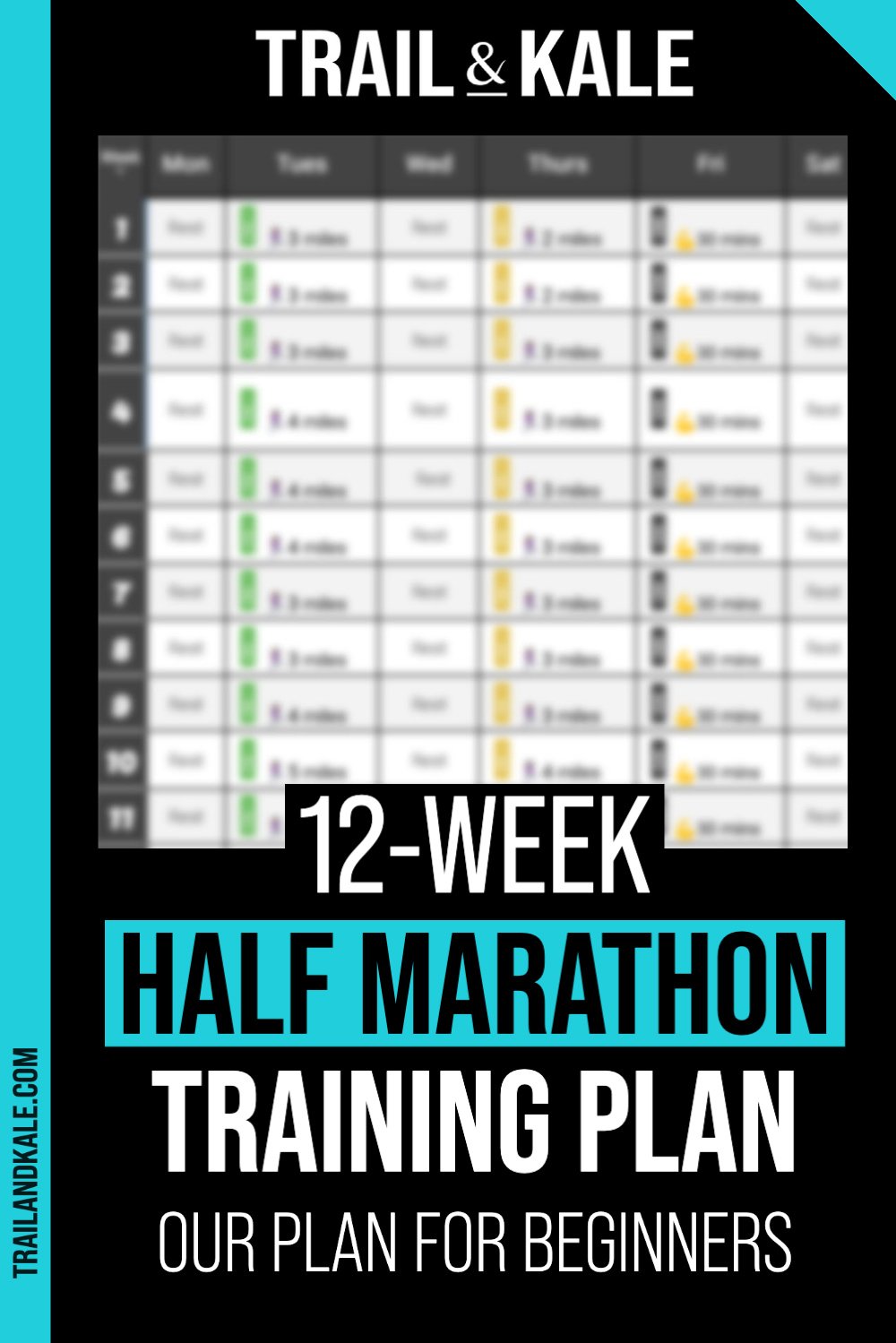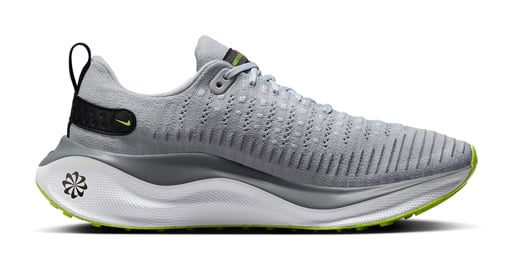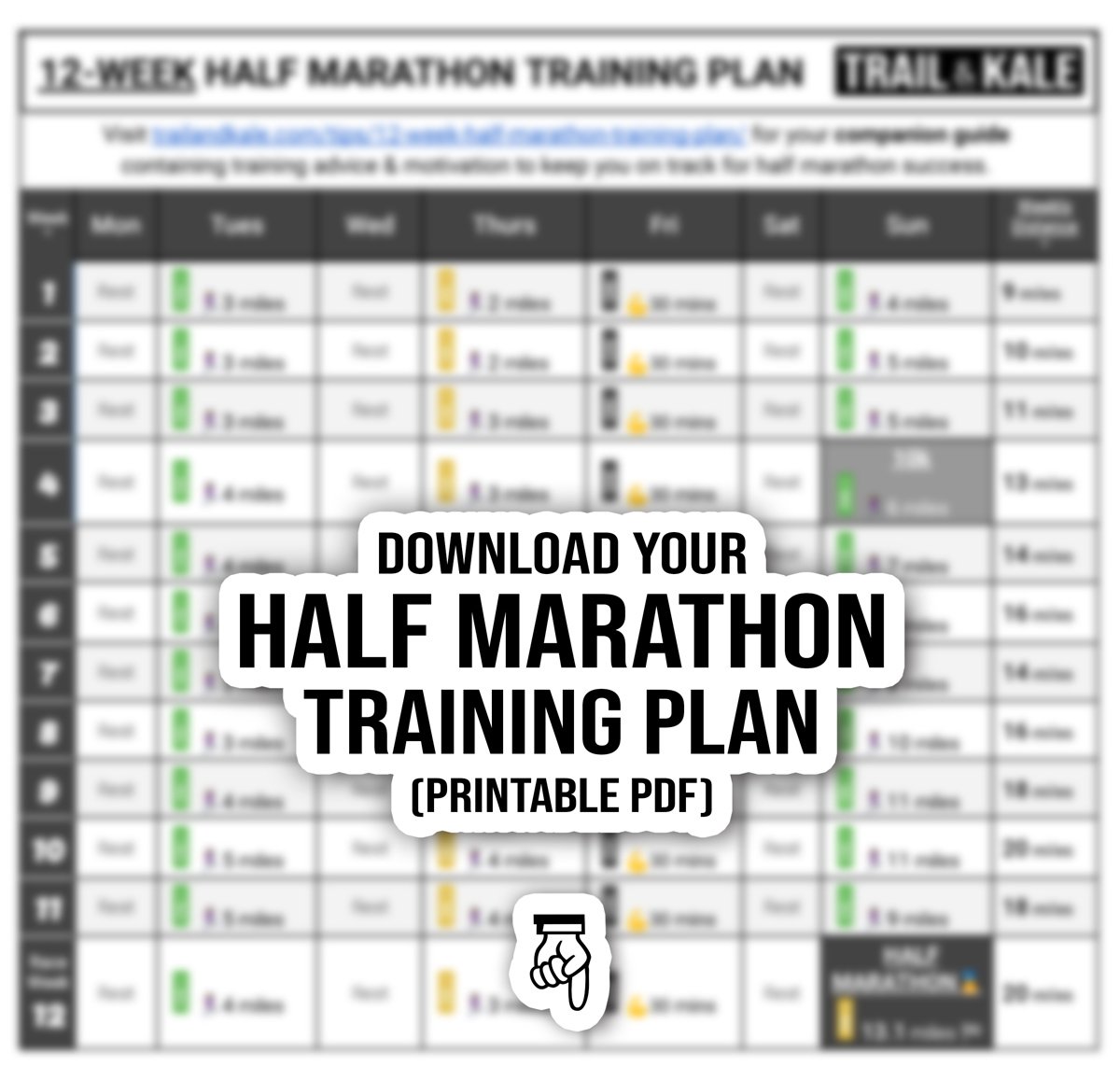Running your first half marathon can be a life-changing experience, both physically, in terms of the fitness and strength gains your half marathon training will help you achieve, and mentally through increased patience, confidence and ability to endure, as you work towards that finish line goal!
I’m Alastair, one of the founders of Trail & Kale, and I’m excited to share our half marathon training plan for beginners with you.
I started running in my mid-20s, and after running my first half marathon I’ve gone on to run many half, full and ultra-marathons all over the world, although I’ll let you into a little secret… after 100s of races, the half marathon distance is still my favorite!
This post is in partnership with Nike. If you’re looking for a supportive running shoe with enough cushioning and response to help you complete your half or full marathon training; the Nike InfinityRN 4 could be the perfect choice for you. Read my in-depth Nike InfinityRN 4 review to learn more.
What’s in this 12-week half marathon training plan
- Who this half-marathon training plan is for
- Overview of our half marathon training plan for beginners
- How to prepare for your first half marathon
- Advice to optimize performance, improve post-run recovery and prevent injuries
- Tips for race day success
- Our FREE downloadable 12-week half marathon training plan pdf (printable)
- COMPANION GUIDE for this 12-week training plan
With this guide, you’ll have all the information you need to start your half-marathon journey and achieve your goal of crossing the finish line.

Who this half-marathon training plan is for
Runners who can run 5k (around 30 minutes) non-stop and want to step up to half marathon distance
If you already run a little and can comfortably run 5k, then this beginner runner half marathon training plan is perfect for you to build up to running your first half marathon over 12 weeks.
If you’re used to running several times a week and can comfortably run 10k, then you should also consider whether our 12-week intermediate half marathon training plan, or our more advanced, speed-focused 6-week half marathon training plan may be a good option for you.
If you used to run, but haven’t for a while
If you’re coming back from a break in running, but have that past experience, you may find you have the residual strength and ‘miles in your legs’ to pick up your half marathon training with this 12-week plan.
Active non-runners
If you are already an active person who does some other exercise and has a level of existing fitness but doesn’t run regularly, then you may find that you can jump into this beginners half marathon training plan with no additional preparation.
That said, also consider if you should do a few weeks from our Couch to 5k training plan (say at least the last 3-4 weeks of that program) if you need a little more time to build up to running 3x a week.
If you are not currently a runner and have not run before
If this sounds like you, you have a little more preparation to do, which starts with using our 8-week Couch to 5k training plan to build up to running up to around 30 minutes at a time (around a 5k in distance, or 3.3 miles).
This will allow you to work your way up to that baseline and ensure you’re physically prepared before coming back to this 12-week half-marathon training plan for beginners.
If you’re interested in our shorter half marathon training plans, or would prefer to train to run a full marathon or even your first ultramarathon then head over to our training plans homepage.
Overview of this half marathon training program
This is a 12-week half marathon training plan designed to help you train for a race in 12 weeks / around 3 months’ time.
Do you have a time goal in mind? This chart should help you predict roughly what your potential half marathon time could be based on your average pace:
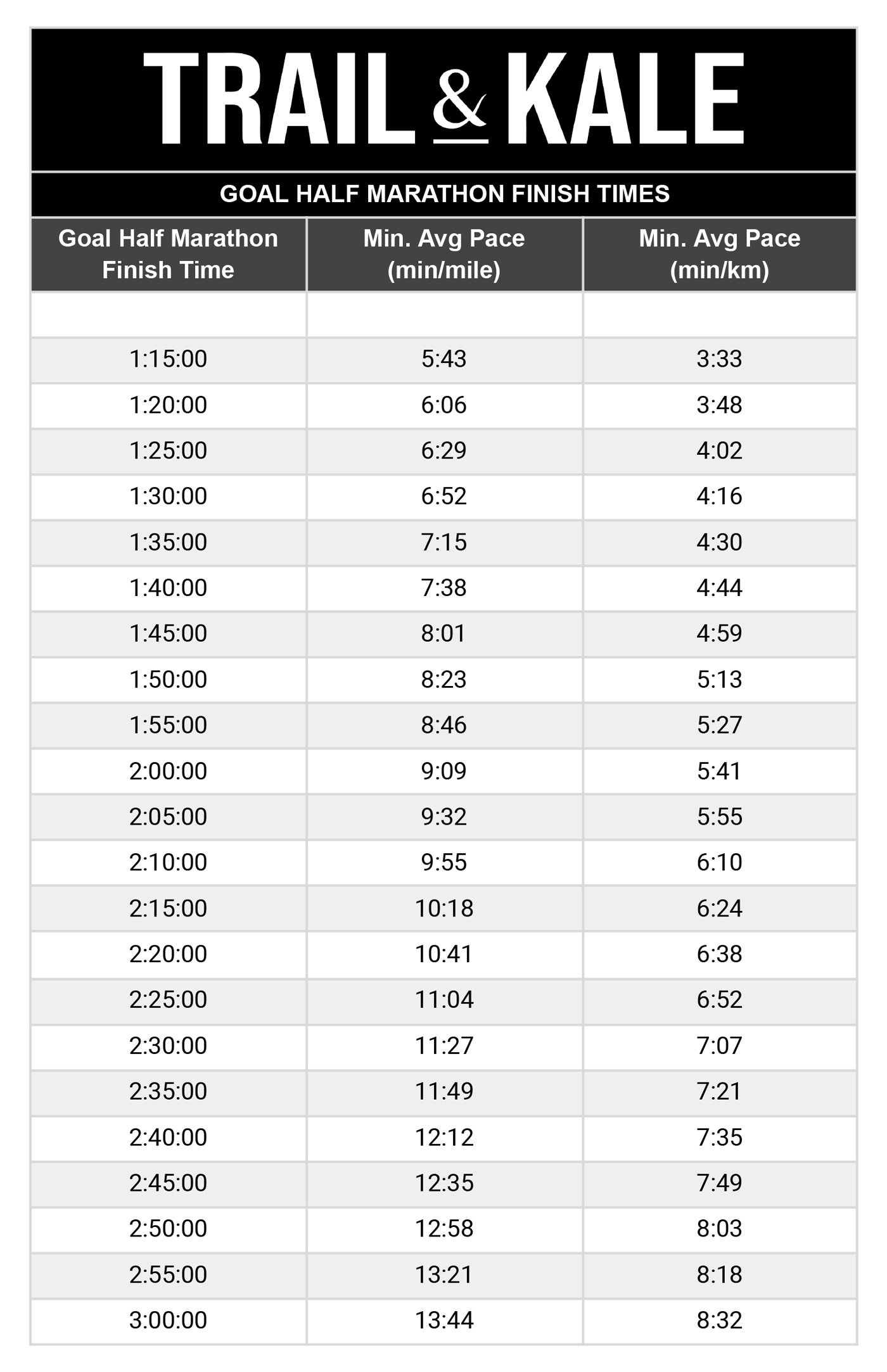
As with our other endurance running training plans, the plan is structured so that you do several runs a week, of different durations and intensities, with most of the miles being run at a comfortable, conversational pace.
In case you’re wondering, ‘conversational pace’ means running at a pace where you can speak in short sentences while running without getting overly out of breath.
Your training plan will include a ‘long run’ at the end of each week.
The long run is important because this is the training run that will train your body and mind to run slightly longer durations (and distances) each week, as you build up the strength and confidence to run the half marathon distance.
This half marathon training plan for beginners also includes rest days, and a day assigned to core strength training.
These non-running days are also important components for your overall strength and recovery.
Although this training schedule does not specify cross training days, depending on your level of fitness and speed of recovery between runs, you can also do some cross training on your rest days, such as static cycling (any bike works but I personally love my Peloton) or a trail hike.
How to prepare for your first half marathon
Check your fitness level
Before embarking on any running training program, it’s important to be honest with yourself about your current fitness level. If you have concerns, consulting with your doctor beforehand is a wise decision.
If you’re inexperienced with cardiovascular exercise, such as running, spending an additional 8 weeks gradually increasing your endurance to run for 30 minutes continuously may be beneficial.
Our Couch to 5k program is a great resource for achieving this goal before beginning a half marathon training regimen.
Heart rate zone training
All of our half marathon training plans take advantage of the benefits of using heart rate zone training as a highly effective way to plan, monitor and track running effort levels and performance over time based on your own personal level of fitness.
Heart rate training is personalized to you based on your individual heart rate, and provides ranges for you to train within, called ‘zones’.
Read our easy to follow guide to heart rate zone training to learn how to work out your heart rate zones, and how to track your heart rate while you’re running to ensure you’re in the target heart zones as outlined in our downloadable training plan below.
Gather the gear you need to run comfortably
What shoes and gear you wear for your half marathon training (as well as race day) will make a big difference to your comfort and enjoyment levels, especially on those tougher long weekend runs.
As expert running gear reviewers we have a comprehensive set of running gear buyer’s guides based on our extensive experience of testing and reviewing running shoes, apparel and accessories!
If you’re looking for a supportive running shoe with enough cushioning and response to help you complete your half or full marathon training; the Nike InfinityRN 4 could be the perfect choice for you!
Read my in-depth Nike InfinityRN 4 review to learn more.
Below is a list of necessary items for half marathon training and race day, along with a few non-essential items that may be necessary depending on the time and location of your run:
- A quality pair of running shoes
- Running socks
- Running tights or shorts
- For women, a running-appropriate sports bra
- A running tee or vest
- A waterproof running jacket
- Running sunglasses
- A running hat
Optional items to consider for running in the cold are warm gloves, a warm hat and a warm baselayer such as a merino wool tee.
For running in the dark then a good running headlamp is essential and a reflective running vest is a good idea, too.
Finding time in your schedule to fit training in
One of the most important things to remember when starting this training process is that dedicated, consistent training will help you achieve that half marathon goal.
Before you start this beginner half marathon training plan, review the plan, together with your personal schedule and plan out when would be the best days and times to fit in your run and core strength training over the next 12 weeks.
Many people find it beneficial to fit in their runs in the early morning, so it’s done for the day before you get stuck in to everything else you have to do in the day. If you don’t consider yourself an early bird, read our guide to becoming a morning runner for some tips.
Otherwise, running at night is a popular choice for people who have a safe place to do their run training, so if you plan to do this plan your training routes in advance, and bring enough warm clothes, reflective gear and a headlamp to keep you comfortable and help ensure you can be seen (and see where you’re running!).
Lunchtime is another great time to fit in a 20-40 minute training run.
Making healthy lifestyle changes
Training for a half marathon is not just about running, or even just the combination of running and other training that’s listed on our free training plan pdf.
What you do when you’re not running is just as important. You can really help make training easier and more enjoyable by taking steps to develop a healthier lifestyle, which can include:
- changing your diet to eating more whole foods and less processed foods, salt and sugar
- reducing your alcohol intake
- creating a good environment for sleep and ensuring you get enough of it!
Implementing lifestyle modifications like these can significantly boost your energy levels (essential for endurance training), enhance your overall well-being, and for many individuals, lead to weight loss resulting from a combination of dietary modifications and increased physical activity.
Advice to optimize performance, improve post-run recovery and prevent injuries
This advice will help you make the most out of every single half marathon training run.
Before your run: Readiness, fuel, and dynamic stretching
Be prepared – get your running shoes, clothes, watch and accessories together in advance – especially if you plan to get up early to run!
Eat before your run – while you may not find this necessary for your shorter weekday training runs, it’s important to eat before your weekly long runs to ensure you have high enough energy levels to sustain running for extended periods.
Dynamic stretching – is super important as part of your 5-10 minute pre-run warm up. There’s a video demonstration of our recommended pre-run dynamic stretches in our post on stretches for runners.
During your run: Technique, heart rate monitoring, and nutrition
Develop good running technique – this includes ensuring you’re working on efficient breathing, running form and cadence during your running workouts.
Monitor your heart rate – our half marathon training plans are most effective for runners who are able to monitor their heart rate using a running watch. We’re big proponents of heart rate zone training, as it’s personalized to your own heart rate data so you can ensure you’re running each run at the right level of intensity.
Nutrition as you run – Unless you’re going for shorter runs in chilly conditions, it’s advisable to carry water with you on every run. Additionally, it’s important to educate yourself on appropriate fueling while running, especially for runs that extend beyond an hour. Energy gels and chews are popular and convenient choices for this purpose.
After your run: Static stretching, recovery, and injury prevention
Static stretching – don’t forget to do some good static stretching after you finish each run. It will really help with flexibility and reduce post-run soreness. These are our favorite static stretches.
Post-run recovery shake – a quality plant-based protein shake will make a huge difference in reducing post-run soreness and helping your body recover after an intense endurance effort or strength training. I suggest having one after every run that lasts over an hour.
Get plenty of rest and sleep – another proven way to help recover quicker, make sure you’re getting enough good quality sleep and that on rest days, you truly do rest!
Tips for race day success
Here are our top tips for half marathon race day success! Bookmark this post and come back to it as you approach race day:
A few days before
- Take a few days off from running, as prescribed in this half marathon training plan
- Eat and drink particularly clean, remembering to drink plenty of water to stay hydrated
- Connect with any friends and family who will be coming out to support and spectate at the race. Agree on what mile marker or landmark they’ll be near, and if they’ll be on the left or right of the barriers! They may want to make a funny or motivating sign for you, too!
- Plan where you’ll go for post-race celebrations. Perhaps a bar or nice restaurant near the finish line? If necessary, make a reservation.
The night before
- Prepare your gear – gather your shoes, clothes, running watch (make sure it’s charged) accessories, water, nutrition, race bib and safety pins
- Prepare your drop bag – if you need to, put essentials in the drop bag and put it by your running shoes so it’s ready to grab and go the next morning and you don’t forget it. Items you’ll want in here may include your phone, a warm layer, a snack and a change of shirt.
- Set your alarm
- Prepare your breakfast
- Check the weather
- Plan your route and timing to get to the start line. If applicable, know where you’ll park and allow plenty of time for parking and walking to the start area, including a visit to the restroom and to drop off your drop-bag at the designated location.
- Know your start time and what wave you’re running in
- Have a nice early meal and get an early night!
Race day morning
- Eat a good breakfast around 2 hours before the race start
- Leave for the start line with plenty of time to park, drop your drop-bag, walk to the starting corrals, and find a porta-potty to use the bathroom in. Remember there will be thousands of other people there so prepare for queues to park and use the bathroom, which will add to the time!
Running your first half marathon race
- Stay calm at the start. It can be an intense experience waiting to start, with so many other runners around you, but take a deep breath, calm your heart rate and soak up the fun atmosphere! Remember all the hard work and sacrifices you’ve made to get to that start line, so don’t forget to enjoy yourself!
- Smile as much as possible. I mean it! You probably won’t have a choice, given how wonderful the atmosphere is when the route is lined with people who came out to cheer you on. Be sure to smile at those photographers – you’ll want a souvenir photo, after all 🙂
- If you’re wearing a running watch, remember to stop it when you’ve crossed the line so you have your race time saved.
Our FREE downloadable 12-week half marathon training plan for beginners pdf (printable)
COMPANION GUIDE for our 12-week half marathon training schedule
Our 12-week training plan is designed to be simple to follow and prioritizes running consistency and the importance of your weekend long run to train yourself both physically and mentally to be able to run the half marathon distance.
This companion guide is designed to be a reference to your 12 week training plan, we developed it to ensure you’re on track for success, rather than mindlessly following when to run, how long for, and how intense that run should be.
We believe in teaching you the foundations of running technique, and sharing our top tips for nutrition and running gear based on our extensive product reviews to help you get the most out of your training runs, and race day!
It also includes a milestone for the first 10k distance you hit in the training plan, which is 4 weeks into the 12 week plan.
If you’d like to, it could be a good idea to find a local 10k race to sign up for that weekend, rather than doing it as another regular run near home.
A 10k race should be a fun day out, as well as a good opportunity to get some experience of what to expect from running with thousands of other runners on your half marathon race day!
Train using heart rate zones
Effort levels for each run are specified based on ensuring you’re running in target heart rate zones 2 or 3, which you’ll monitor using a running watch that tracks your heart rate.
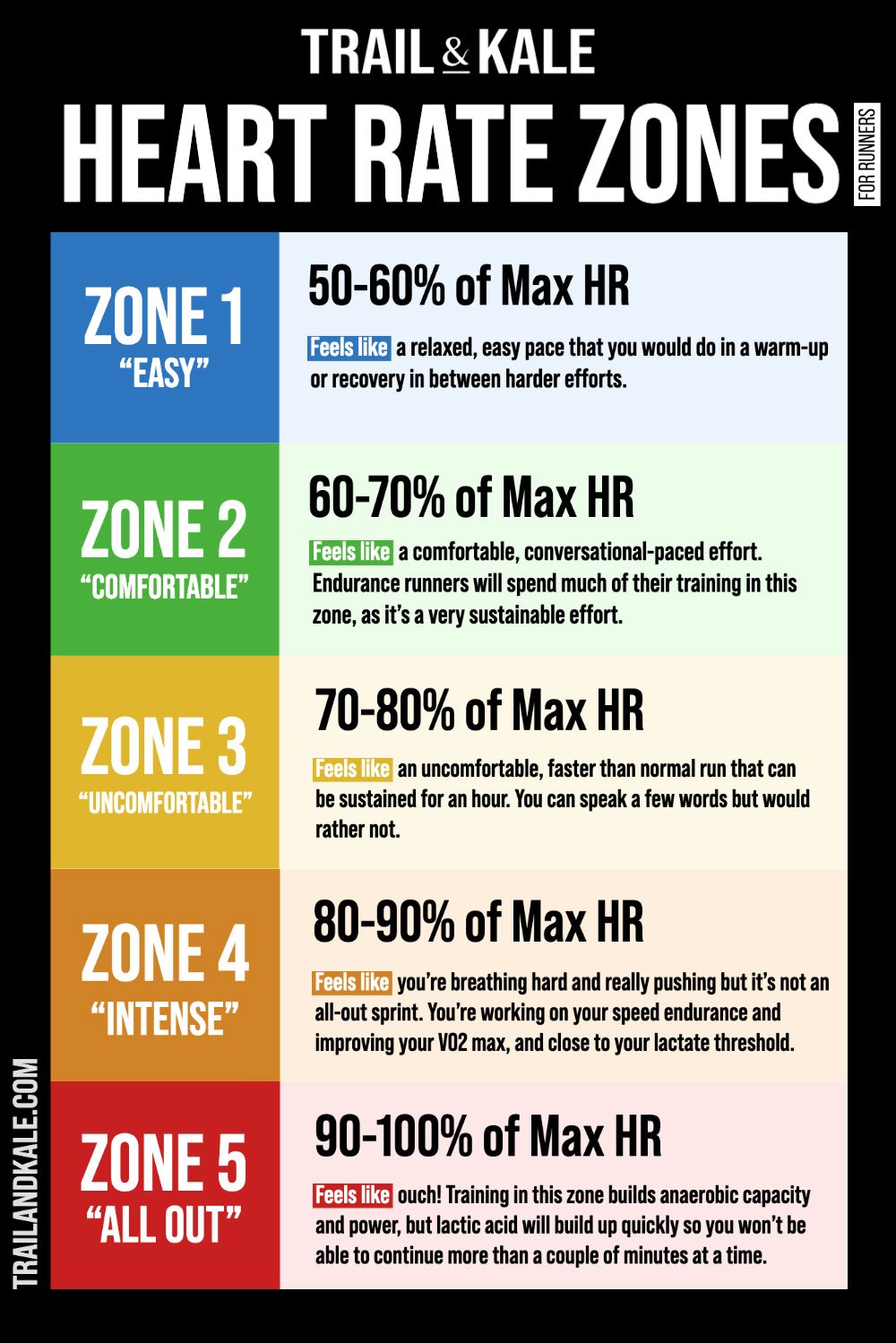
Read our heart rate training post to learn how to calculate your personalized heart rate zones, which is an essential part of how and why our training plans work so well.
You can also use this training plan without specifically using heart rate zones and tracking your heart rate, if you wish, but you’ll need to gauge your effort level based on your perceived effort, rather than using heart rate data.
Most of the runs in this half marathon training schedule are run at Zone 2, or ‘comfortable, conversational pace’ but there are a few higher intensity runs that step up to zone 3.
Your default shorter Thursday run is a more intense, Zone 3 run.
However, if you have a particular time goal in mind, then you may want to consider running your Wednesday run as either a tempo run, 2-minute speed intervals, fartlek or hill repeats training session, for at least your scheduled distance, or around 30-45 minutes in duration.
Doing these more intense runs will help you run faster and improve your VO2 max, but be mindful that it increases your recovery time and these more intense runs may not be suitable for you if you’re newer to running and need to prioritize safely and steadily building up your endurance rather than speed.
Warm up and cool down
Before every run, spend at least 5 minutes doing a warm up, which should include dynamic stretching.
After every run, spend 5 minutes cooling down until your heart rate is back comfortably in Zone 1. Then spend at least another 5 minutes doing some static stretches to help reduce soreness and promote flexibility and range of motion.
Our guide to stretches for runners lists our favorite dynamic and static stretches.
Core and strength exercises
Friday is your training plan’s ‘core and strength’ day.
This session should be around 30-45 minutes long, and focus on core stability and overall strength training, which you can do using your bodyweight and little or no additional weights or gear.
I suggest doing circuits of the following exercises into your core and strength sessions for an all-round core and strength session.
Do around 90 seconds on each, and repeat the circuit three times:
- Bodyweight squats
- Lunges
- Bird-dog
- Bicycle abs
- Fire hydrants
- Planks
- Side planks
- Glute bridges
Rest days
Monday, Wednesday and Saturday are your rest and recovery days.
This doesn’t mean you shouldn’t do some activity, though, but take those days off from running. Depending on how you feel, you could do some yoga, breathwork, stretching, light cross-training (such as riding an indoor bicycle) or take a hike.
Happy training!
I’m excited for your half marathon training journey and hope you find this 12-week beginners half marathon training program to be an easy-to-follow and enjoyable companion along the way!
PIN ME!
